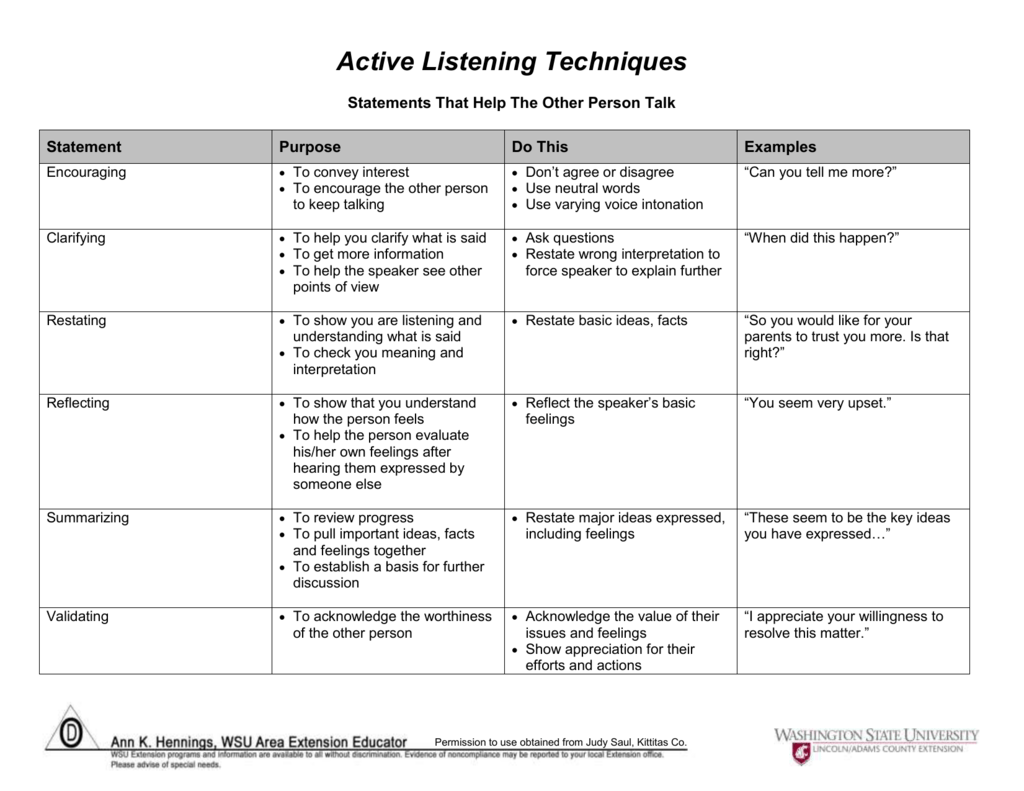

In order for your learners to enhance this excellent communication skill, consider the following tips: 9 Tips To Enhance Active Listening Skills In eLearningĪctive listening skills can be difficult to master and therefore it takes time, determination, and patience to become an excellent active listener.
ACTIVE LISTENING STRATEGIES HOW TO
They can also access knowledge that they’ve previously acquired to make connections with new concepts or ideas, and decide how to apply this information in real world settings.

When learners are actively listening during the eLearning course, they are able to more effectively process the information and engage with the subject matter, instead of merely being passive observers. Thus, they are able to absorb the key takeaways of the eLearning course and commit them to their long-term memory, rather than being overloaded with all data that is flowing into their mental pathways.Īctive listening is so crucial in online learning environments because it distinguishes learners who are actually participating from those who are merely going through the eLearning course material. When the process of information recall takes place, learners are triggering their memory schemata, which improves comprehension and helps them identify which eLearning content is useful and relevant and which can go by the wayside to make room for really valuable data. Only after all these factors are taken into consideration, your brain can then begin to absorb the information. Even the pitch of someone’s voice or their tone plays an important role in the process. While actively listening, your mind also takes subtle nuances into account, such as gestures, expressions, colors, images, and body language. It must first understand the context of the eLearning content presented, then pair it with personal feelings, experiences, or previous knowledge. You may had been present, but your mind was not.Īs far as the cognitive processes involved are concerned, while you are actively listening, your brain goes through a variety of different tasks.

This is a perfect example of hearing instead of active listening. To best illustrate the idea of active listening think back to a time when you sat in on a lecture or meeting and remembered absolutely nothing that was discussed after the fact. It involves focusing on the subject matter, processing it, and comprehending the concepts. This also explains why active listening is not just listening to what is being said, but also absorbing it. During active listening, our minds focus on the information just received and process it accordingly this is when truly amazing learning experiences take shape. The individual must first choose to concentrate, and then, the brain has to process this information to add contextual meaning. While hearing is the involuntary act of perceiving sound, listening actually requires some effort.

While “hearing” and “listening” are two words that are often used interchangeably, there are many contrasts between them. First Things First… What Is Active Listening?
ACTIVE LISTENING STRATEGIES PROFESSIONAL
Active listening is an essential quality all learners should have, as it can greatly improve their communication skills and help them build strong relationships. In this article, I'll delve into the basics of active listening that every eLearning professional should know in order to develop eLearning courses that enhance learners' active listening skills, so that you will be able to help your learners to engage both mentally and emotionally in every conversation, and achieve long-term success in their personal and professional lives. Having active listening skills means that you are able to communicate effectively and create deeper connections with others. But what does it take to become a great listener? Only one thing, actually: Practicing and improving your active listening skills. The way we listen can have a major impact not only on our personal relationships, but also on our professional lives and job performance.Ī good listener has the ability to better understand and process information a great listener has the ability to use this information to negotiate, influence, and avoid misunderstandings and conflicts. More than a half-century later, little has changed indeed, most people don’t listen, despite listening being one of the most important human skills. Most people never listen.”, Ernest Hemingway once said. “ I have learned a great deal from listening carefully. Active Listening In eLearning: What eLearning Professionals Should Know


 0 kommentar(er)
0 kommentar(er)
